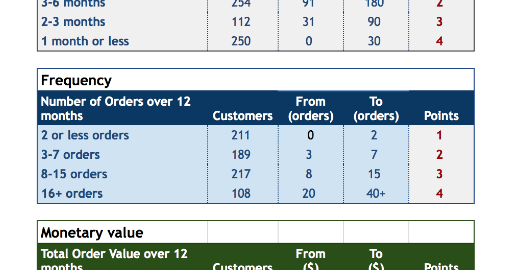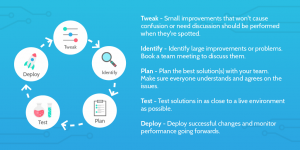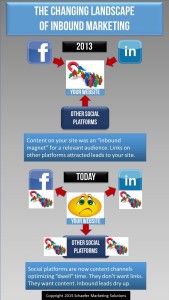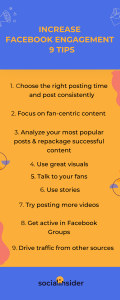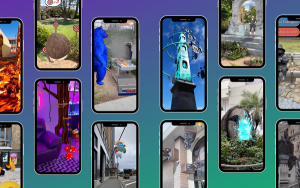
This article is part 3 of our series on Ecommerce Personalization. Catch up with part one, How to Implement Basic Site Segmentation and Part two, Personalized Marketing: How to Implement 1:1 Segmentation.
My previous article delved into the the nitty gritty of implementing an ecommerce personalization strategy; which was broken in three distinct segments: using on-site targeting, email driven 1:1 product recommendations and on-site personalized product recommendations.

Using the CRAWL – WALK – RUN approach to ecommerce personalization, this final article will cover the RUN aspect of personalization –– i.e. high value customer identification or influencer identification using RFM analysis to help you develop more targeted personalization campaigns.
I will be covering the following facets of the RFM model:
- Scoring: determining the value of customers based on
- Recency: identifying the most recent purchases
- Frequency: identifying number of repeat purchases
- Monetary analysis: average order value analysis and total spend analysis over a period of time
As the saying goes in running a business: Turnover is vanity. Profit is sanity. But cash is king
In the context of marketing and scaling the growth of an ecommerce business, I’ll say that: Sales are vanity. Retention/Loyalty is sanity. But advocacy is king.
Every e-tailer’s utopia would be to get as many customers actively and happily sharing their positive ecommerce brand experience with their friends, colleagues and family. This is in effect, word of mouth marketing –– which is free and very profitable. The key determinant of customer happiness is customer experience. Personalization aims to optimize customer experience both on-site and on email messaging with relevancy. More relevant product recommendations, offers and messaging make a net positive experience.

Breaking it to its bare essentials, here is what the customer journey process looks like:
- Discovery: potential customers become aware of your ecommerce brand
- Intent: browsing through your site when they are in purchase mode (top of mind brands stand to benefit)
- Choice reduction in a bid to make a final purchase decision
- Converting to finally purchasing
- Order fulfilment: same day, next day delivery or free shipping
- Issue resolution with your customer services team in the event of any problems arising (like hassle free returns)
- Returning customers and reactivating inactive customers through email if your products are replenishable or require a seasonal refresh (as in the case of fashion merchandising) and
- Advocacy: happy customers sharing their ‘unboxing’ experience, telling friends at dinner parties and happily recommending your brand due to their memorable experience. They are more or less sharing their positive experience.
Personalization really should be infused in all of the above steps, but the areas in which it has the highest impact are at the intent stage (when shoppers are browsing your website), choice reduction and nurturing returning customers. Optimizing these phases of the customer journey as well as the more physical aspects –– i.e. order fulfillment and issue resolution –– drive up the proportion of customers that will eventually become advocates.
Advocacy is the one metric the most ambitious of ecommerce marketers watch very closely. It is exemplified in its rawest form as brand name searches and direct traffic. Happy customers will share the name of your ecommerce brand or its website address –– meaning that their friends will simply search for your brand OR type your URL in their address bars. You can see this in your Google Analytics as an increase in direct traffic or branded search terms.
Building an RFM Model
When you have optimized both on-site and off-site experience for customers with a truly holistic and integrated personalization strategy, how do you discover your most valuable customers that bring in the highest conversion rate?
The RFM methodology is an acronym for the following three segments:
- Recency is measured in days. You’d need to set a threshold meaningful to your business because the fewer the days from a customer’s last purchase the better.
- Frequency is measured as the number of order per year from each customer. For some businesses, their best customers order monthly and for other replenishables-oriented businesses, their best customers order weekly.
- Monetary analysis is the total order value over a period of time –– typically a over a year.
Marketers use the RFM model to filter out and score each customer by their most recent purchase by date (which is the ‘recency’ segment), by each customer’s number of orders (their purchase frequency) and then by their cumulative order value over a specified period of time (for the monetary analysis piece).
Each customer record should have the following fields in order to carry out RFM analysis for your store:
- Total Order Value
- Average Order Value
- Total Number of Orders
- Last Order Date
- Value of Last Order
- Date of First Order
- Value of First Order
- Average Number of Days Between Orders
The output of an RFM analysis would look something like this (this is from OroCRM):

As you can see from above, the analysis is split out into 3 segments for recency, frequency and monetary value with points awarded to each segment.

Image source: OroCRM
In the recency segment, this company designated the score of 5 to customers that have not ordered over the last two months. In the frequency segment, customers that have made less than 5 purchases in the past year are also designated the score of 5. And in their monetary value segment, customers’ whose cumulative spend over the past year has been less than $ 5,000 are designated the ‘worst’ score of 5.
Their highest rated customers are graded a top mark of 1 if they have made a purchase in the last 7 days, have had 50 or more orders in the past year and spent more that $ 20,000 over the past year.

The spreadsheet above on the other hand gives lower numeric scores to top performing customers by recency (0-30 days), frequency (16+ orders in the last 12 months) and monetary value (total orders over $ 500).
How Should Marketers Use RFM Scores?
Here are a few ways to use RFM scores to improve your marketing decisions and rules for 1:1 personalized email campaigns:
RFM scores should be used to create segments for personalization
Your RFM analysis will help you establish segments for existing customers such as high value customers, most active customers and newest customers. By doing this, you are able to merge your revenue goals with better targeted unique messaging and personalized offers. RFM analysis can also help you create segments that identify inactive customers.
RFM scores should be calculated by channel
For multichannel retailers, RFM scores should be calculated by channel in order to better understand the quality of customers per channel.
Integrate RFM scoring into your shopping cart abandonment strategy
RFM scores could be used to determine the incentive value threshold you are willing to offer customers that have recently abandoned their shopping carts. As an example, higher value customers with order totals above a set threshold could be given steeper discounts to complete their purchase.
Your Three Types of Customers According to the RFM Model
High recency, high frequency and high monetary
Customers scoring highest for recency, frequency and monetary value will be in your most loyal customer segment and should be rewarded with exclusive offers and special privileges. For example, shipping could be free to your best customers.
High recency, low frequency and low monetary
Customers in this segment will most likely be your newest customers. Make sure you put your best foot forward, by sending them welcome offers, product-guides or relevant information to get them accustomed to your brand and store.
Low recency, low frequency and low monetary
These will be deemed your inactive or least engaged customers. You would either want to attempt to re-activate them or double-check to see if they should remain on your list as customers.
Wrapping Up
I’ll wrap up by saying that RFM analysis should be at the heart of your personalization strategy. Use RFM to send better-personalized emails, for more targeted product recommendations and in your on-site targeting.
Once RFM segmentation is integrated into your customer list and ecommerce site, it is a relatively simple way of delivering more tailored messaging to your customers based on their past behaviors.
Use it as a strategic base for all your segmentation activity in order to help increase conversions and response rates. Depending on the nature of your online retail business, you will most likely find that, 10-25% of your customers account for 60-80% of sales (the 80/20 rule). Stats on customers that have only purchased once (whom I refer to as one-night standers) will be startling –– and you really can’t argue with data!
Digital & Social Articles on Business 2 Community(95)
